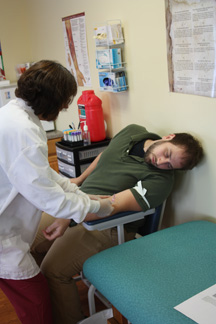How to Manage Patients Who Pass Out
Knowing how to prevent fainting during a phlebotomy procedure is critical
When a patient passes out during a venipuncture procedure, this post details exactly what to do and what not to do.
by Dennis Ernst • July 19, 2021

Anyone who draws blood samples sooner or later has a patient pass out during or following the procedure. How do you react? How can you prevent it? Patients have become paralyzed by those who didn't know. Don't be one of them.
Those who draw blood specimens must constantly be aware of the signs and symptoms of an impending loss of consciousness and be prepared to react. Signs can include pallor, perspiration, hyperventilation and/or anxiety. A proper response to such signs is key to protecting the patient from falling and the injuries that can result. However, collectors can prevent an injury before it happens if they take the following precautions:
- make sure that all outpatients are drawn from chairs with arm rests that can stop a fainting patient from falling to the floor;
- never draw a patient sitting upright on an exam table or in a chair without side armrests;
- inpatients should be drawn while recumbent or sitting in arm chairs with arm rests, not upright on the side of the bed;
- patients with a history of fainting during a blood draw should be drawn while they are in a recumbent position;
- never turn your back on a patient, especially after you have completed the draw. Some patients give no warning before passing out.
- do not get more than one step away from a seated patient while he/she is in your care. Should they pass out, you must be close enough to prevent a fall.
- should a patient become dizzy or lose consciousness during a collection, release the tourniquet, remove the needle, and activate the safety feature at once. Presence of mind must be maintained so that you don’t sustain an accidental needlestick in the process.
- if the patient loses consciousness, support him/her from falling to the floor and summon assistance. Lower the patient’s head below the level of the heart to facilitate blood flow to the brain. This can also be accomplished by carefully, and with assistance, lowering the patient’s head between the knees or by lowering the patient to the floor, being careful not to allow the patient to fall and sustain an injury.
- avoid the use of ammonia inhalants. Patients who are asthmatic may develop respiratory distress as a result.
Statistics say 2.5 percent of patients will pass out during or immediately after a blood draw. Being prepared significantly reduces the risk of injury and complications secondary to the loss of consciousness. If you ask if they've ever fainted during a blood draw, the rate goes up to 5.6%. Never mention "faint" or "pass out." The power of suggestion just might make it a reality. Instead, ask patients if they've ever "had problems" with prior blood draws. If they respond affirmatively, explore the nature of the incidents and react appropriately.
Preventing fainting episodes are just as important as knowing what to do when it happens. It's never unexpected by those who are well prepared.

and receive notices when I create every new post.
Related Posts and Information
overall rating: my rating: log in to rate
faint fainting lose consciousness outpatient pass out YouTube
109 Comments
How to Manage Patients who pass out
I had no idea that a fainting Patient could become paralyzed. Very interesting reading.
Dennis Ernst, 08/02/2021 18:02:22
How to manage patients who pass out
The information was on point, because it happens to me more often then not. Thanks.
Dennis Ernst, 08/06/2021 08:33:25
